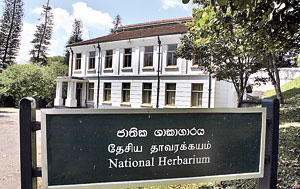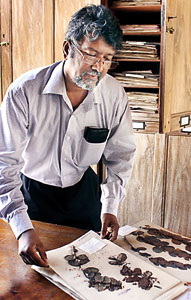For most, it is just a walk through the gardens, sometimes enjoying the misty splendour or at other times the sunbathed glory of the well-laid out land by the quietly flowing Mahaweli.
Relaxing under the canopy of a large tree, walking along the hallmark avenue of royal palms or looking in wonder at the bright and beautiful flowers, how many realize that the Royal Botanic Gardens at Peradeniya has the highest diversity among gardens in the region.
 |
| The National Herbarium houses a collection of 148,000 dried specimens from all over the country. Pix by M.A. Pushpa Kumara |
 |
While providing a serene and tranquil environment, proven by the fact that 1.4 million are lured by its beauty, Peradeniya plays many roles - a major one being the ex-situ conservation of plants. This is the conservation and maintenance of living organisms, in this case plants, outside their natural habitats.
There are 4,500 different species of plants including trees, shrubs, bushes et al, the Sunday Times learns.
With the air in Kandy said to be more polluted than Colombo, this Botanic Gardens is reported to have the best air in the area.
Behind the manicured and tended areas is also taking place important work connected to the flora of Sri Lanka.
Deep within the Peradeniya Gardens in a charming building fitted with wooden almirahs, glass-showcases and numerous shelves, meticulously preserved are specimens of each and every plant or tree in the country.
It is the National Herbarium with a massive collection of 148,000 dried specimens reported from all over the country, even the remotest corner, the Sunday Times understands. With the specimens come detailed information on where and when the plant was collected, its habitat, colour and the name of the collector.
Explaining that some of the specimens at this national bio-repository are nearly 200 years old, the Director-General of the Department of National Botanic Gardens, Dr. Siril Wijesundera said the National Herbarium represents a valuable floral catalogue.
This is where the "birth certificates" of plants are, he says, adding that the National Herbarium is also involved in plant exploration, identification, specimen preparation and documentation and revision of the floral wealth of the country.
Here is the Wintergreen plant taken way back in 1855 at Horton Plains, says Dr. Wijesundera walking us through the National Herbarium, pointing out that when the leaves of the plant are crushed the wintogeno odour comes out strongly.
Colour-coded with red being for "native" plants, green for cultivated plants and brown for exotics or aliens, if the plant is not at the Herbarium either it is new to Sri Lanka or new to science as in not being named, he says.
As such a Herbarium is vital to study plant taxonomy (coming from the Greek taxis or "arrangement" it means the practice and science of classification), the geographic distribution of plants and also their nomenclature. Flowers, stems, leaves, seed and fruit are preserved alongside a specimen, according to Dr. Wijesundera.
 |
| Dr. Siril Wijesundera shows some
of the specimens |
The staff at the National Herbarium is also involved ‘Red Listing’ plants in the country in collaboration with the Biodiversity Secretariat of the Environment Ministry. Plants are categorized as 'extinct', 'critically endangered', 'endangered', 'vulnerable', 'near-threatened', 'least concerned' and 'data deficient'.
Close to the National Herbarium is another building, now refurbished and equipped for batches of people to pore over microscopes, mix different chemicals in petri dishes for experiments involving plants or listen to both local and foreign experts.
In this building now turned into an education centre, Louis Mountbatten, the Supreme Commander of the Allied Forces in South Asia made his office in the hill country, as well as an ammunition dump during World War II in the early 1940s.
The other achievement that the Botanic Gardens is proud of is the National Floriculture Development Programme, 'Suvahas Mal' under which 85 farmer organizations have been empowered in different spheres such as infrastructure, plant material and knowledge to cultivate both flowering and ornamental plants.
The farmer organizations are in the Central, North Central, Western, Sabaragamuwa, Uva and Southern Provinces, according to the Director General and at the Botanic Gardens the nucleus where the growers have been trained is the model farm with green houses where rows and rows of orchids, anthuriums and other flowers are nurtured.
Proving his initial point that it is not just a malwatte, Dr. Wijesundera's vision is to make the Peradeniya Royal Botanic Garden "the best in the tropics" by 2015 by maintaining that special quality that emanates from here……..the aura of tranquillity and serenity, along with its pristine majesty.
History of our gardens
The history of the Peradeniya Gardens goes back into the dim mists of time when in 1371 King Wickramabahu III first used it as a royal pleasure garden, followed by King Kirthi Sri Rajasinghe declaring it as a 'Royal Garden’ in 1780.
By 1799, close to Colombo in Peliyagoda, the then British Governor Frederick North established a botanic garden in 1799, with the services of Frenchman Eudelin de Jonville.
'Kew Gardens' with Joseph Banks taking a hand came into being in 1810 in Slave Island, Colombo, with the first Superintendent William Kerr being appointed in 1812. However, relocation at Ukgalboda on the banks of the Kalu Ganga at Kalutara followed in 1814 and Alexander Moon took up the mantle in 1817.
Peradeniya became the home of these gardens in 1821. |




